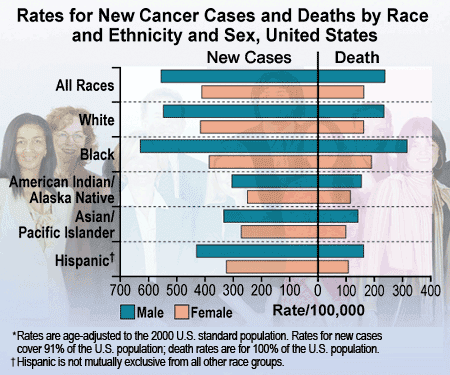Rates for New Cancer Cases and Deaths by Race and Ethnicity and Sex
Talk to your doctor about ways you can reduce your cancer risks.

According to CDC's Office of Minority Health and Health Disparities, life expectancy and overall health have improved in recent years for most Americans, but not all Americans are benefiting equally. CDC and its partners monitor trends in cancer incidence (diagnosis) and mortality (deaths) and identifies which groups are affected disproportionately.
Health disparities are differences in the incidence, prevalence, and mortality of a disease and the related adverse health conditions that exist among specific population groups. These groups may be described by gender, age, ethnicity, education, income, social class, disability, geographic location, or sexual orientation.1
Incidence2
Among men in the United States during 2001 to 2005 (the most recent 5-year period for which statistics are available), black men were most frequently diagnosed with cancer, at a rate of 632.9 per 100,000. White men had the second highest incidence rate at 551.2 per 100,000, followed by Hispanic* men at 433.7, Asian/Pacific Islander men at 337.2, and American Indian/Alaska Native men at 308.3.
Among women in the United States during the same time period, white women were diagnosed with cancer most often at a rate of 419.5 per 100,000, followed by black women at 388.3, Hispanic* women at 327.7, Asian/Pacific Islander women at 274.3, and American Indian/Alaska Native women at 253.0.
Deaths2
Among men in the United States during this 5-year period, black men died from cancer at a rate of 313.0 per 100,000, followed by white men at 230.7, Hispanic* men at 158.9, American Indian/Alaska Native men at 151.5, and Asian/Pacific Islander men at 138.8.
Among women, black women had the highest death rate at 186.7 per 100,000, followed by white women at 159.2, American Indian/Alaska Native women at 111.8, Hispanic* women at 105.1, and Asian/Pacific Islander women at 95.9.
*Hispanic is not mutually exclusive from white, black, Asian/Pacific Islander, or American Indian/Alaska Native.
Cancer Prevention
Some types of cancer can be prevented with a vaccine or found early through screening. Learn how to reduce your risk of getting these cancers by visiting Preventive Cancer Screening and Vaccination.
Data Sources
1National Cancer Institute. Health Disparities Defined. Rockville, MD: U.S. Department of Health and Human Services, National Institutes of Health, National Cancer Institute.
2U.S. Cancer Statistics Working Group. United States Cancer Statistics: 1999–2005 Incidence and Mortality Web-based Report. Atlanta (GA): Department of Health and Human Services, Centers for Disease Control and Prevention, and National Cancer Institute; 2009. Available at: http://www.cdc.gov/uscs.


